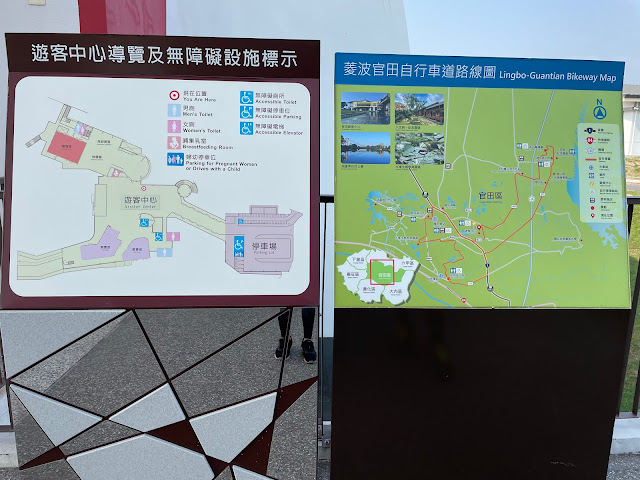It was our son's birthday, so after celebrating at home, we wanted to find an outdoor place. He received a soccer ball as a gift and couldn't wait to bring it to the field. While driving around Gantian, we spotted a large grassland and the visitor center in the distance. It was our first time visiting this place. Initially, there weren't many people, but as the afternoon progressed, it became quite busy. People came here for walks, flying kites, and even picnics. The area is quite spacious, although there aren't many trees, so finding shade was a bit difficult.
Guantian Visitor Center - Siraya Tourist Center (西拉雅國家風景區管理處官田遊客中心)
The Guantian Visitor Center, opened in August 2020, covers an area of approximately 11 hectares. The park's landscape combines elements of "village settlements" and the Siraya culture, depicting the terrain of the Jianan Plain. It serves as a new landmark for local tourism, connecting major scenic spots such as the Wushanto Interchange on National Highway No. 3, Batian Yoichi Memorial Park, and Wushanto Reservoir, thereby promoting local tourism. The building's overall design follows the traditional settlement style of the Siraya people facing the water. In addition to providing complete facilities, the center also showcases local agricultural special products for exhibition and sales.
Opening hours: Monday - Sunday; 09:00 – 17:00
Who are the Siraya people?
The Siraya (西拉雅; Xīlāyǎ) people are an indigenous group in Taiwan. They historically inhabited the flat coastal plains in the southwest part of the island, including areas now known as Tainan City and Taitung County. The Siraya consist of at least four communities: Mattauw, Soelangh, Baccloangh, and Sinckan, corresponding to the modern-day districts of Madou, Jiali, Shanhua, and Sinshih, respectively.
As Plains indigenous people (Pingpu), the Siraya inhabited flat coastal regions rather than mountainous areas. Like other indigenous peoples in Taiwan, they are ethnically and linguistically Austronesian. The name "Taiwan" originated from the Siraya language, which is part of the Austronesian language family. Taivoan and Makatao were previously considered Siraya communities but are now recognized as independent indigenous groups based on linguistic discoveries, cultural features, and the self-identification of these indigenous peoples.
After the Qing Dynasty annexed the port in the Siraya area of Taiwan in 1683, the Siraya language gradually fell out of use due to a process of acculturation. The last recorded regular use of the language was in 1908 during the Japanese rule of Taiwan. Most Siraya families adopted Hokkien Chinese as their mother tongue, while Japanese and Mandarin Chinese were learned in schools as the government-mandated lingua franca. However, despite the linguistic shift, the Siraya have maintained many aspects of their culture. Some families in Xinhua Township, particularly in Tso-chen, Kou-pei, and Chiou-chen-lin, still identify themselves as Siraya. The Siraya Culture Association was established in 1999, and the teaching of the reconstructed Siraya language began in schools in 2002. In 2005, the Tainan County government formed a Siraya Aboriginal Affairs Committee and funded the development of a glossary containing over 4,000 Sirayan words, which was released in 2008.
Traditionally, the Siraya lived in villages that were often in conflict with one another. Women were responsible for agriculture and religious activities, while men engaged in hunting, warfare, and decision-making. Married couples did not live together, with wives residing with their parents and husbands in men's quarters. If they wanted to see each other, husbands would have to visit secretly. The Siraya had a unique practice where most women did not have children until their mid-thirties. If a woman became pregnant before that, an abortion was usually performed by the village shaman. Many women underwent multiple abortions during their lifetime because the Siraya believed that childbirth and child-rearing had a negative impact on success in warfare. Consequently, childbirth was postponed until the husband retired from being a warrior, typically around the age of forty, and his wife was a few years younger, still having a few years of childbearing capacity.
On February 14, 2006, researchers from Taiwan's Academia Sinica announced that they had deciphered up to 80% of the Sinkang Manuscripts, a set of documents written in the Siraya language from the 17th and 18th centuries. These manuscripts were part of the Dutch missionaries' efforts to convert the Siraya to Christianity. The Dutch studied the Sirayan language, created a romanized script, and began translating the New Testament. Copies of the Dutch translation of the Book of Matthew into Sirayan have survived, and several manuscripts are bilingual, containing both Sirayan and Chinese versions.




























0 komentarze:
Post a Comment